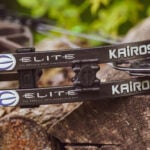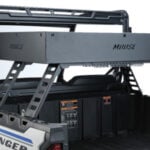When I first started using a kayak to hunt, there was practically zero information online about it. I searched and searched, and often came up empty handed with the exception of a few duck hunting articles. It made it very difficult to prepare for my first season of kayak hunting when there weren’t really any experts offering advice.
For me, everything was learned solely by experience in the field, or I guess, on the water. These days it seems there’s been an uptick in interest. A few die hard hunters have learned that this is an incredibly effective way to get to unpressured areas, and it’s peaked the interest of people across the country.
Luckily, new kayak hunters now have a fair amount of content to consume to help them get into the game of hunting with a kayak. That being said, I want to share with you five tips from things I have learned throughout the years of successfully hunting from a kayak. I hope this helps you in your preparations, and maybe gets you one step closer to paddling out that big buck.
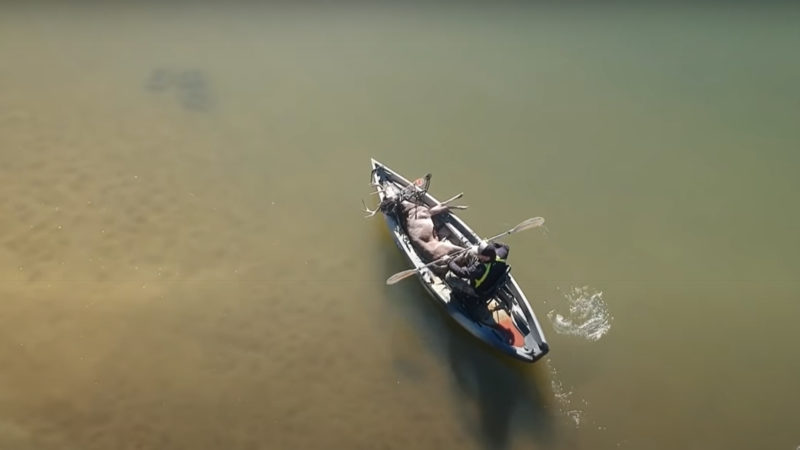
1. Safety Above All Else
I will admit that this has been my weakness when it comes to hunting from a kayak. I have not always followed the necessary safety rules as well as I should, but have slowly learned the importance of it. Kayak hunting naturally involves more effort than a hunter may be used to, so it’s easy to skip some of the steps out of convenience. However, it also involves quite a bit more risk. Remember that your life and safety should be the number one concern before you step foot in the kayak.
Here are several ways I think you can decrease the risk involved in kayak hunting.
First, wear a PFD (life jacket). This has been one area that I have not been faithful. The fact is, hunting season is usually very cold. I know from experience that trying to swim in below freezing temps is virtually impossible. Your body freezes up. Your limbs don’t move as quickly as they should. It’s a scary situation. Not to mention that if you’re wearing rubber boots, they will fill up with water and basically become weights attached to your feet. It’s not a good situation.
These days there are PFDs that you can wear that aren’t bulky. The co2 charged PFDs, like the one from Onyx, are an investment, but if needed, they’ll be the most important piece of equipment you have.
Another safety precaution is letting someone know where you are at all times. If you’re doing it right, you should be going into places where there is minimal human intrusion. Which also means that there will be no one there to help you, should you find yourself in a bad situation.
When you go out, share your location with someone and make sure they know exactly where you are. Have a time set for you to check back in when you’re out of the woods. If you don’t check in by that time, that person will know something has happened and be able to inform the proper authorities to ensure your safety. The majority of your time on the water during a kayak hunt will be before and after daylight, so again, the risk is there.
Another safety measure is having a 360 degree light somewhere on your kayak. This allows other boaters to be able to see you. In most states this is actually a law, so make sure you know your area’s regulations before you go. There are many more safety precautions involved in kayak hunting, but you should always use sound judgement. If you think there’s even a possibility of danger, just remember that there are people who want to see you make it out alive.
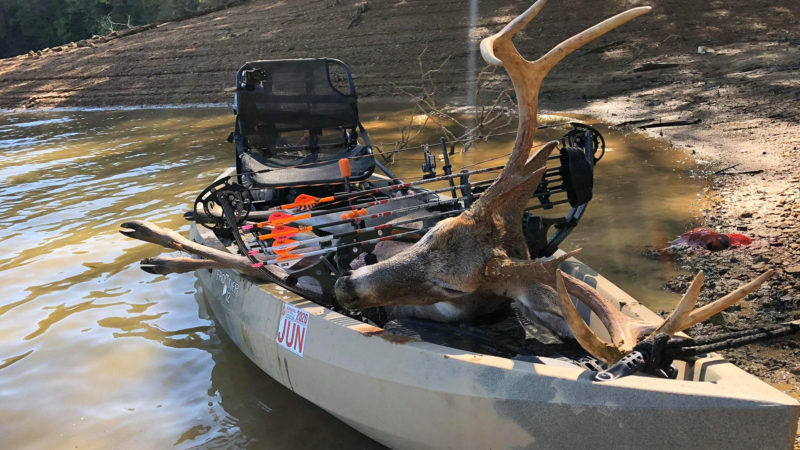
2. Have a Success Plan
I’ve always been the type of deer hunter that would go into an area without first thinking about how I’m going to get a big buck out if I were to kill one. After all, our main goal is to kill deer.
That being said, a kayak hunter should always have a plan in place to get the deer out, should they be successful. In my Nucanoe Frontier 12, it’s very easy to load a full grown buck in the boat without compromising my safety during transport.
I also realize that most people are not using a kayak of this caliber, so the transportation aspect could possibly get a little bit interesting.
There are many ways I’ve seen it done, but here are three that I think could be relatively easy for anyone:
Pack Out Method – If I were planning to use a kayak with a lower weight capacity, this would definitely be my first choice for transportation. Quartering up your deer involves a little bit more work, but it significantly decreases the amount of weight you have to put on your kayak. Not only does it decrease weight, but it cuts down on the amount of space it will take up. I would suggest having a backpack that is designed to pack out game, and you’ll be set!
Tow A Raft – This was my first idea for transport, when I originally decided I wanted to try kayak hunting. Luckily, every kayak I’ve ever hunted with had a high weight capacity, but I still think this method could be very useful and easy. Most kayaks have some sort of dry storage built in. I would suggest finding a cheap inflatable raft that you can keep deflated in your dry storage compartment so it doesn’t take any space, and then you have it ready to go should you be successful. Make sure you also pack a rope to tether the raft to your kayak, and just pull it behind you. This method will slow you down significantly, but once you’ve got the buck, who cares?
Life Jacket Method – This is my least favorite of the transport options, but I’ve seen it done successfully several times. All you would do here is carry an extra PFD, strap it on the deer, and pull it behind your kayak. It is important that you do not field dress the animal before transport, as the gut cavity will give added buoyancy. You also don’t want the water to taint the meat inside of the cavity. Like the raft method, this will significantly decrease your speed. I would also not recommend this method if you’re in the deep south with gator infested water.
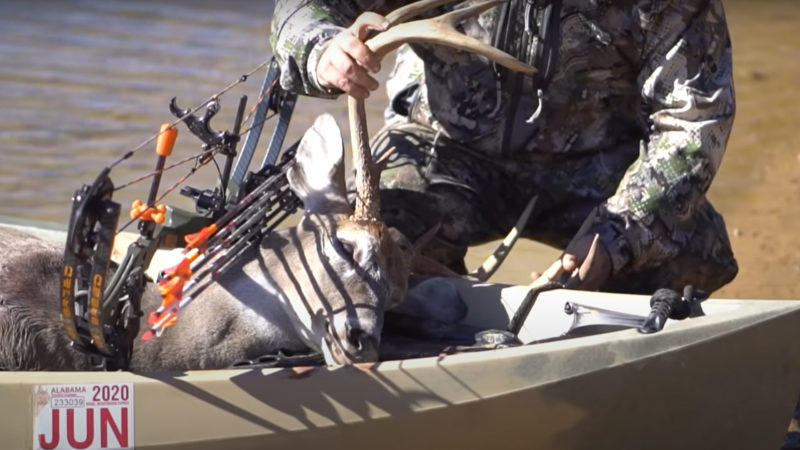
3. Use Lots of Leashes
My biggest nightmare is that I’m going to have an accident on the water and all of my gear is going to fall into the depths of the lake, never to be seen again. This actually happened to my dad while we were hunting one cold December day in 2017. Luckily, the water was only about 15 feet deep in that spot, and we were able to recover everything.
This made me a firm believer in keeping all of my gear leashed to the kayak at all times. It’s such a simple solution to ensure nothing gets lost, and it can be very cheap. Most outdoor stores will carry some type of paddle leash, but that cost starts to add up.
I take about 3′ of paracord and attach a cheap carabiner to each side. One carabiner attaches somewhere on the boat and the other to the piece of gear. It’s cheap, easy, and effective.
4. Distance Scouting
You’ve read a lot at this point about your setup, but I want to share a bit of kayak hunting tactics here. If you’ve decided you want to start kayak hunting, it’s likely due to wanting to get away from a lot of hunter pressure in your area. I have had minimal human intrusion in my kayak hunts, but when I do, it’s typically due to my lack of preparation and scouting that was to blame.
I do most of my scouting on onX maps. Normally I start with a launch point and try to find the public areas within about a 7 mile boat ride that are the furthest away from any parking area or road system. However, there have been just a couple of occasions that I found an area that was thought to be land/water locked, only to get there and find a well used gravel road leading right into the parcel.
Your mapping app is great, but you can not beat in-person intel. For all of the areas I hunt now, I will take some time to drive around the entire radius of the property to check every possible access point, and searching for roads that may not show up on the map.
There’s nothing worse than paddling for an hour or two, only to realize there’s a road system 100 yards from your destination. Distance, water, and terrain are the main things that deter most hunters from going into an area. Something I always do is try to make sure I’m at least a mile away from any walk-in access spot, with either steep terrain or some sort of water system between. If I don’t have that, then I’m assuming there are people hunting it on a regular basis. That doesn’t mean there aren’t deer in the area, but just that it might be easier to walk in than kayak.
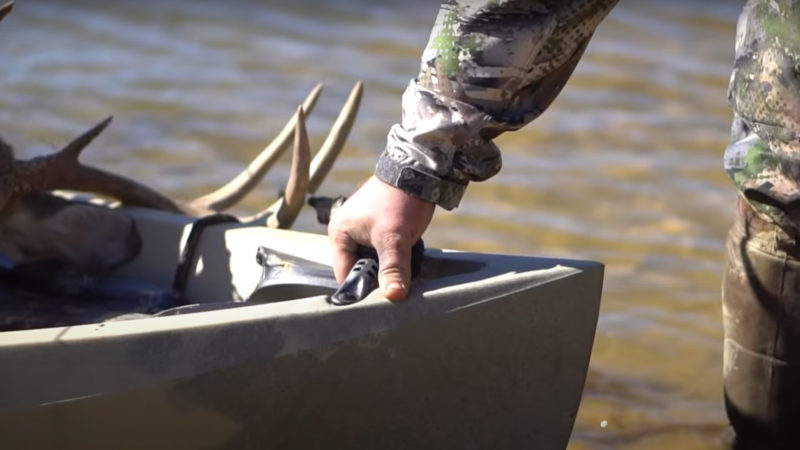
5. Be Aggressive
One of my favorite aspects to kayak hunting is the fact that it is so stealthy. I have found that deer do not spook out of an area, even if they see me paddling by them. I can’t tell you how many sets of eyes my light has shined before daylight, only to see those same deer in the same spot once I’m set up. They simply do not associate the water with danger. This is why I really like to use the water advantage as much as I possibly can during each kayak hunt.
If there is a creek that might get me closer to the spot I intend to hunt, I will always opt to paddle as close as I can. We all know that familiar sound of leaves crunching under our feet. Well, so do the deer. The sound of a paddle going through the water may not be quiet, but it’s much less alarming to a deer.
Deer likely live their whole life close to water. They’ve heard fish jump every day, beavers slap their tails on the surface, and loads of other sounds coming from the water that they’ve never had to associate with danger. I am convinced that using the kayak method is the most stealthy way to aggressively access your hunting area, short of being able to fly.
Final Thoughts
There are so many advantages to kayak access, I couldn’t even begin to name them all in one article. The reality is that most of your knowledge about this style of hunting will come from time spent doing it. But I can promise you one thing, if you’ll stick to it, and don’t give up, you will set yourself up for the adventure of a lifetime when hunting from a kayak.

 By
By 
